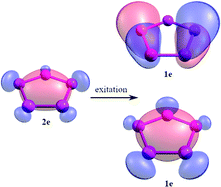Chemical bonding analysis of excited states using the adaptive natural density partitioning method†
Abstract
A novel approach to chemical bond analysis for excited states has been developed. Using an extended adaptive natural density partitioning method (AdNDP) as implemented in AdNDP 2.0 code, we obtained chemically intuitive bonding patterns for the excited states of H2O, B5+, and C2H4+ molecules. The deformation pathway in the excited states could be easily predicted based on the analysis of the chemical bond pattern. We expect that this new method of chemical bonding analysis would be very helpful for photochemistry, photoelectron spectroscopy, electron spectroscopy and other chemical applications that involved excited states.



 Please wait while we load your content...
Please wait while we load your content...